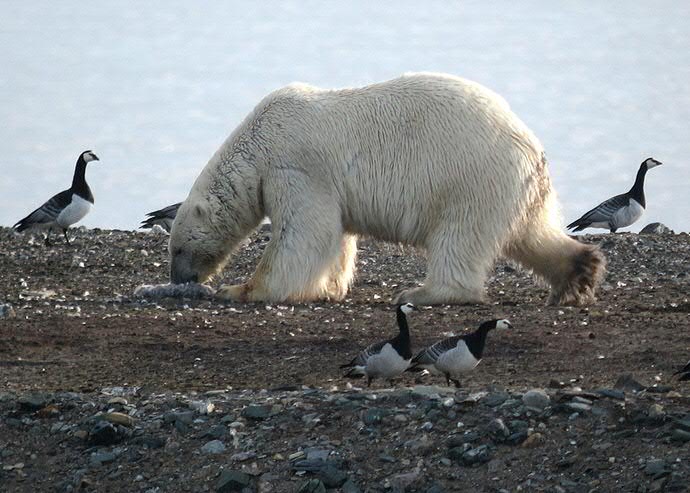IJsberen gaan eieren eten door verdwijnen zee-ijs

Door de veranderende ijsomstandigheden in het Noordpoolgebied passen ijsberen hun consumptiepatroon aan. Een toenemend aantal ijsberen verliest in de zomer contact met het zee-ijs en richt zich op eieren van vogels. Dat hebben biologen van de Rijksuniversiteit Groningen samen met buitenlandse collega’s ontdekt.
Het zee-ijs in het Noordpoolgebied verdwijnt in rap tempo. Dit heeft grote gevolgen voor de dieren die er van afhankelijk zijn. De ijsbeer is hiervan een uitgesproken voorbeeld: die heeft zee-ijs nodig om prooien te vangen. De ijsbeer volgt in de zomer het zich terugtrekkende zee-ijs, op zoek naar prooien. Maar is dat nog steeds mogelijk?
Energierijke eieren als voedselbron
Biologen van de Rijksuniversiteit Groningen hebben met buitenlandse collega’s opvallende verschuivingen ontdekt in de verspreiding van de ijsbeer, die samenhangen met de veranderende ijsomstandigheden. Sinds het begin van deze eeuw blijkt een toenemend aantal ijsberen in de zomer contact met het zee-ijs te verliezen. Deze dieren blijven steken op land.
IJsberen zijn afhankelijk van zee-ijs om hun prooien te vangen. Op land vormen eieren van vogels die in kolonies broeden, zoals ganzen en eenden, een alternatieve voedselbron, althans voor de beperkte periode van de broedtijd. De nesten zijn voor een beer relatief gemakkelijk te vinden en de eieren bevatten veel energie.
Jaarlijkse terugkeer
Het RUG-onderzoek op Spitsbergen laat zien dat zodra ijsberen een vogelkolonie hebben ontdekt, de beren het volgende jaar terugkeren. Dat gebeurt elk jaar een paar dagen vroeger, en daarmee zijn de ijsberen in staat een steeds groter deel van de eieren te pakken. Voor de vogels heeft de komst van ijsberen tot gevolg dat steeds minder jongen uit het ei kruipen. Verder onderzoek moet uitwijzen of de vogelpopulaties opgewassen zijn tegen dit verlies, en of ijsberen ook op langere termijn kunnen profiteren van vogeleieren als voedselbron.
Spitsbergen én Groenland
Het internationale onderzoek van de biologen laat zien dat bovengenoemde ontwikkeling opmerkelijk synchroon verloopt langs de westkust van Spitsbergen en aan de oostkust van Groenland. Dit wijst erop dat grootschalige processen zoals een opwarmend klimaat hierbij een rol spelen.
Meer informatie
- Publicatie: ‘Climate change and the increasing impact of polar bears on bird populations’ in Frontiers in Ecology and Evolution (als bijdrage aan het Research Topic: Climate change and marine top predators), doi: 10.3389/fevo.2015.00033
Meer nieuws
-
20 november 2025
Geleidende hydrogel is zacht voor de hersenen
-
20 november 2025
Wat als we mentale aandoeningen anders zouden indelen?
-
18 november 2025
Raketten, robots en regels
